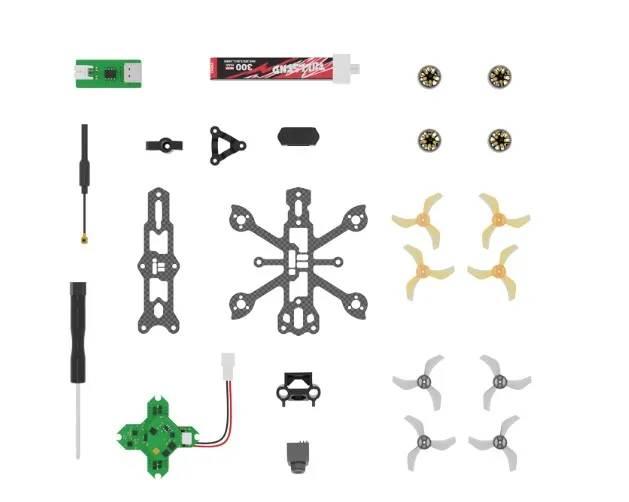Introduction to Drone Parts
Diving into the world of drone piloting brings excitement and challenges, especially when assembling your first drone. Understanding the essential parts is vital for a smooth flight experience. Here’s a comprehensive guide to the top 10 must-have drone parts for beginners.
Frame
Material and Durability
The drone’s frame serves as its backbone. Opt for lightweight yet durable materials like carbon fiber or aluminum to ensure both agility and strength during flights. A sturdy frame can withstand crashes, crucial for beginners honing their piloting skills.
Motors
Brushed vs. Brushless
Selecting the right motors significantly impacts a drone’s performance. Brushless motors offer greater efficiency, longevity, and power compared to brushed ones. They generate less heat and require minimal maintenance, ideal for beginners seeking reliability.
Propellers
Size and Pitch
Choosing appropriate propellers involves considering size and pitch. Larger propellers can provide more thrust but might drain the battery faster. Understanding the pitch’s impact on speed and maneuverability aids in optimizing the drone’s flight characteristics.
Flight Controller
Integrated Features
A quality flight controller acts as the drone’s brain, stabilizing its flight and enabling various features. Look for integrated gyroscopes and accelerometers for better stability, especially for beginners learning to navigate different flying conditions.
Batteries
Capacity and Chemistry
The battery’s capacity and chemistry determine flight duration and overall performance. Lithium polymer (LiPo) batteries are popular for their high energy density, providing longer flights, but proper care and handling are crucial to avoid accidents.
Transmitter and Receiver
Range and Channels
A reliable transmitter-receiver duo ensures seamless communication between the pilot and the drone. Opt for a system with adequate range and multiple channels, offering better control and stability during flights.
FPV System
Goggles vs. Monitors
First-person view FPV drone systems enhance the immersive flying experience. Choosing between goggles and monitors depends on personal preferences, with goggles offering a more immersive experience while monitors provide better visibility in varying light conditions.
Gimbal
Stability and Control
For capturing stable and clear aerial footage, a gimbal is indispensable. It stabilizes the camera, compensating for the drone’s movements, ensuring smooth and professional-looking videos or images.
GPS Module
Accuracy and Functions
A GPS module enhances a drone’s capabilities, offering precise positioning and navigation features. Beginners benefit from GPS-assisted flight modes that ensure easier control and added safety features like return-to-home functions.
Tools and Accessories
Maintenance and Upkeep
Besides essential parts, investing in tools and accessories for maintenance is crucial. Items like propeller guards, spare parts, and carrying cases ensure readiness for any situation and prolong the drone’s lifespan.
Conclusion
Assembling your first drone can be both thrilling and daunting. Understanding the significance of each part is pivotal for a successful flight experience. By prioritizing these top 10 drone components, beginners can build a reliable and efficient drone for sale their adventures.
Pros of Drones
- Aerial Photography and Videography: Drones offer stunning perspectives for photography and filming, especially in inaccessible or high locations.
- Efficiency in Surveys and Inspections: They aid in conducting surveys and inspections more efficiently and safely, particularly in industries like agriculture, construction, and infrastructure.
- Search and Rescue Operations: Drones assist in search and rescue missions by covering large areas quickly and accessing hard-to-reach places.
- Cost-Effective Delivery: Companies explore drone delivery options for quicker and cost-effective transportation of small packages to remote areas.
- Recreational and Entertainment: Drones are popular for recreational purposes, allowing enthusiasts to enjoy flying and capturing moments from a unique perspective.
Cons of Drones
- Privacy Concerns: Misuse of drones can invade privacy, leading to concerns regarding surveillance and unauthorized recording.
- Regulatory Challenges: Stringent regulations and airspace restrictions pose challenges for drone enthusiasts and businesses, limiting their usage in certain areas.
- Safety Hazards: Accidents involving drones can cause injuries or damage property, especially if not operated responsibly.
- Limited Battery Life: Most drones have limited flight times due to battery constraints, restricting their operational duration.
- Environmental Impact: Concerns arise about the environmental impact of drones, including noise pollution and potential disturbances to wildlife.
FAQs
1. Do all drones require the same parts?
Each drone might have specific requirements, but these components are fundamental for most beginner-friendly models.
2. Are there any safety precautions for handling drone parts?
Yes, especially with batteries. Always follow manufacturer instructions and handle them with care to prevent accidents.
3. Can I upgrade these parts later?
Certainly! As your skills evolve, upgrading parts allows you to enhance your drone’s performance.
4. Are all propellers compatible with every drone?
No, drones have specific propeller sizes and mounting mechanisms. Always check compatibility before purchasing.
5. Do I need to assemble these parts myself?
Depending on the model, some drones come pre-assembled, while others require assembly. Always follow the provided instructions or seek professional help if unsure.

